Pedasi, Isla Coiba and Bocas del Toro, PanamaContents of this Issue: Pedasi, Isla Coiba and Bocas del Toro, Panama Typhoon Wrecks Truk Liveaboards Fiji, Iceland, Maldives, Raja Ampat Readers Weigh in About Turning Rigs into Reefs The Dive Hood, Your Head and Heat Loss That Dream Trip Can Be Reality How Any Diver Can Negotiate Group Dive Discounts Where Are the Replacement O-Rings? The Latest Hope for Fighting Caribbean Lionfish? Molesting Dive Instructor Sees It as “Just Playing” with Female Divers Editorial Office: Ben Davison Publisher and Editor Undercurrent 3020 Bridgeway, Suite 102 Sausalito, CA 94965 a whirlwind dive trip, with great surface intervals from the May, 2015 issue of Undercurrent
Note from Ben: Years ago, while ensconced at Laguna Beach Diving Resort on Utila, Honduras, my dive buddy and I took the resort boat into town nearly every day to walk about and soak in a little local culture. I thought it odd that no other divers cared to motor in and explore. However, having since traveled to endless other dive destinations, I've concluded that most divers are solely dive tourists, not travelers. They head directly to their destination, dive and go home. To suggest that they skip a day of diving -- or even an afternoon dive -- to see the countryside is often met with indifference. I guess most of my fellow divers have such a deep love of diving, they can't bear to miss a single minute underwater.
* * * * * Dear Fellow Diver: Being within spitting distance of retirement, I've become focused on how to manage the present and future by controlling expenses, rather than obeying financial advisers who suggest I need 80% of my current income to enjoy retirement. As well as diving, my wife and I love to travel the countryside, seeing small villages and eating in restaurants locals frequent. Which set the stage for our latest "whirlwind tour" of Panama, and experiencing my favorite palindrome: a man, a plan, Panama! The Panama Canal got me in hot water with a high school history teacher who insisted it went east to west because it connected the Atlantic and the Pacific. I disagreed, arguing that it went north to south, which I finally observed first-hand last October. My journey began in Panama City, where I stayed in a refurbished 350-year-old colonial house in the Casco Viejo district. Casco Viejo became the center of government in 1671, after Henry Morgan (whose rum brand representation looks a lot nicer than the original) sacked the original capital city. It is about 40 minutes from the airport, and a 10-minute cab ride from the skyscraper-laden downtown. Reasonably priced at $130 per night, I took a modern studio with a kitchen and free internet. Our host gave a quick overview, complete with a map and instructions to go only during daylight to the bustling Avenida Centrals, a more "real" Panama City than the tonier Casco Viego, and a district reminiscent of what I saw in Havana 15 years ago. My Spanish is passable, but the 100-plus years of American presence means that enough people speak English so a gringo can navigate without Spanish. After a visit to the Miraflores Locks, the last and westernmost three enormous locks on the canal, I headed south toward Pedasi to get wet.
The next morning we arrived for a two-tank dive with Pacific Paradise Dive Shop, run by Texas expat Kerri Lusk-Barnes. Having brought only computers and masks, I was pleased with Kerri's top-notch rental gear. Soon, the two of us walked through the surf to board her 26-foot panga for the 30-minute ride to Isla Iguana, a wildlife refuge. Kerri and the captain, Yamedi, were the only others onboard. On my first dive, I spotted a number of turtles, several green morays, many kinds and colors of puffer and porcupinefish, and an old stingray which had lost half its tail somewhere -- we named him Bob. Water temperature was 84 degrees on both dives, visibility ranged from 30 to 70 feet, we wore 3-mil shorties and it was very comfortable. Isla Iguana made for a nice surface interval. Instead of having squirrels interested in your food (Casita Maragarita, our lodging, prepared us a sack lunch), it's iguanas and hermit crabs. But here and there was a Central American stereotype, Panamanian security forces in full gear with automatic weapons. But they were friendly and waved, even taking pictures of themselves, which led me to surmise they were more hanging out than on any dark mission.
Casita Margarita was a pleasant retreat for two nights, but like the old tropics, the bathroom and shower smelled a bit musty and only freshened up with the door open and the A/C on for an hour. An upstairs room would have been preferable; our downstairs room was near the eating area, which got noisy when the breakfast prep started. The owners are friendly Americans, and several expats with stories to tell were hanging around having coffee or beers on the veranda. The room, about $90 per night, included a bacon and eggs breakfast with fresh local fruit; a roasted chicken dinner ran $10. The "mi casa es su casa" policy meant we could help ourselves to wine or beer ($1.50 a bottle), logging what we took and paying when we left. Very friendly and great service. Other restaurant options were limited -- we had some grim Chinese food, also about $10 for dinner. Except for Panama City and later Boquette, most restaurant food was basic -- chicken, rice, some vegetables, fruit. The next day we made the three-hour drive to Santa Catalina, known for its surf break (yes, more surfers), and its proximity to Isla Coiba National Park, a UNESCO World Heritage site, often called the "Galapagos of Panama." I joined Coiba Dive Center (CDC) in Santa Margarita for a day-long, three-tank trip requiring a three-hour round-trip in their 32-foot boat (I'd call it a "super panga") with canvas awning. There were six experienced divers, one new diver doing his checkout dives, two divemasters, a captain and his mate. Once in the water, which was about 82 degrees, visibility went to 50 feet, but 30 feet was more common. CDC's motto is "sharks guaranteed," and they indeed delivered on that promise. After pointing out my 15th white-tip, my buddy shrugged in a "yeah, they're everywhere" sort of way. The dives were all good, with some moments of brilliance. Schools of smaller fish were significant, several hundred of any given species -- chromis, juvenile Creole wrasse and about every shape, size, and color of pufferfish you could imagine. The puffers were literally everywhere. At one point, we all hovered for several minutes as about a thousand (no exaggeration) blue-fin trevally swam by. Later, they proceeded to harass a five-foot white-tip that was minding his own business trying to rest. A few trevally left the school, nipped at the shark, and when it started to swim off, more trevally joined the "fun" and chased the shark.
Another dive, over largely rocky terrain with some coral, revealed four large seahorses, then a six-inch frogfish. A fellow diver took a great video of Senor Frog while he scarfed up a two-inch wrasse that strayed too close. Watching the video later, I saw a second frogfish, about half the size of Senor Frog, wedged just beneath him. Our surface interval at the ranger station on Isla Coiba included a quick tour of the visitor center with basic, mostly graphic displays describing the island's history, the original people living there, its use as a prison from 1919 to 2004, and stories about the prisoners who lived on "Panama's Devil's Island." A white-faced monkey and an agouti or two strolled by on the lawn, but the resident croc was apparently on vacation, alas. ( Undercurrent published a complete review of Coiba diving four years ago, and because it's a protected park, the diving remains the same: www.undercurrent.org/UCnow/dive_magazine/2011/PanamaNationalPark201102.html )
Our digs, the rustic La Buena Vida, provided a small casita with a comic gecko theme -- mosaics (which are all over the property), windows cut in the shape of a gecko, even a four-foot-long painted gecko on the wall above the bed, whose eyes were the reading lights. Because of the tropical grounds, we were advised to shake out shoes and clothes for lizards, scorpions, etc., before dressing. At $90 per night, it was not much of a value, but housing choices were limited; walking around town, it appeared that most options were hostel-like. The small restaurant at La Buena Vida, as were other nearby restaurants, was closed for the October off-season (this was becoming a recurring theme), and the only grocery options were water, soda, beer and salty snacks at tiny bodegas. I lost a few pounds eating only our backup energy bars for meals. Even so, retirement homes for gringos priced at half a million overlooked the beach.
Bordering on Costa Rica, the province of Bocas del Toro has nine beautiful Caribbean islands and a protected marine park. With its basic tourist infrastructure, it has a delightful, laid-back Caribbean feel that's different from the rest of Panama, a destination one could settle into. We did two pleasant dives with La Buga Dive and Surf in water that was 86 degrees, but the visibility was low, averaging 25 feet. After a five-minute boat ride, we dived White House Wall, at a max depth of 65 feet. While it was not a prolific reef, I did see spotted eels, arrow crabs, Pedersen shrimp, brittle stars and a mantis shrimp in a cranny; I've heard these shrimp can break an aquarium wall, so I kept my distance. At the end of the dive, we took a long swim at 30 feet, past reef squid and lots of rope and viscous sponges, even barrel sponges, some up to three feet tall and two feet wide. The second dive at Pandora had a lot of varied sponges (barrel, rope, tube) and coral (plate, lettuce, and boulder). The fish were small, many small hovering balls of tiny fish near the reef. Certainly not stunning, but nice. Other reviews I had read of Bocas diving were at best lukewarm, and while this is not Dominica, it definitely looked like it was making a comeback of a sort, but my observation is based on limited diving. La Buga Dive and Surf had decent gear and a 26-foot fiberglass boat with awning that was comfortable for six divers. Afterwards, the guy in the shop who set us up said there was "proper diving" nearby that cost more, $85 for two tanks instead of their $70; one wonders why. At La Buga restaurant, next to the dive shop, the quesadillas were especially good, and they give divers a 10 percent discount. Nearby I had a good $3 Cuba Libre at the unique local bar named Riptide, literally a boat tied up, back transom open to the bay. At Tom's, down the street from Riptide, there are $5 lunches, nice views and $2 beers. We visited the Wine Bar, hoping to find something other than cheap Chilean Malbec, but that is exactly what they poured. At Koko Resort, we stayed in one of six over-the-water cabins on stilts ($140), with a pass-through bar leading to the kitchen, bath and shower, sleeping loft and an awesome deck with chairs and hammock. Sitting there over the water, with cold beer, watching a stingray muddle past below, staring at the water and the coastline, watching pelicans glide -- memories are made of this! The cabin was not luxurious, but clean, functional and rather spacious for two people. The place is literally right in a local neighborhood, so we walked past the locals' houses and watched kids play soccer on a sawdust-covered lot. Lee and Jack, two retired Americans with a million good stories, run Bahia del Sol, the B&B next door where we went for breakfast (included). Lee was a college professor at Ohio State, and Jack a real estate developer in Ohio (note the Ohio State Buckeye flag on the wall). He's one of those larger-than-life expats I enjoy meeting in out-of-the-way places -- opinionated for sure but helpful to a fault, semi-gruff exterior notwithstanding (for instance, he and Lee persuaded the local sawmill to donate the soccer field sawdust). They are kind people who have a low tolerance for prima donnas expecting a W Hotel, and they spin good tales about people expecting a luxury resort. While I discovered some unique diving as well as pleasant but unsurprising Caribbean diving, I also discovered a country with fine people, an easy pace of living and a beautiful tropical environment. Next time you go diving, I hope you take a few days to see what you can discover.. -- S.F.
|

I want to get all the stories! Tell me how I can become an Undercurrent Online Member and get online access to all the articles of Undercurrent as well as thousands of first hand reports on dive operations world-wide
| Home | Online Members Area | My Account |
Login
|
Join
|
| Travel Index |
Dive Resort & Liveaboard Reviews
|
Featured Reports
|
Recent
Issues
|
Back Issues
|
|
Dive Gear
Index
|
Health/Safety Index
|
Environment & Misc.
Index
|
Seasonal Planner
|
Blogs
|
Free Articles
|
Book Picks
|
News
|
|
Special Offers
|
RSS
|
FAQ
|
About Us
|
Contact Us
|
Links
|
3020 Bridgeway, Ste 102, Sausalito, Ca 94965
All rights reserved.

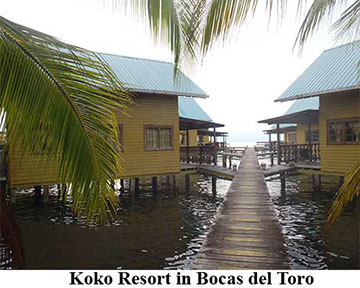 I'm a little different. I've always allocated extra
days or extra time to understand more about where I
visit. For example, I hiked three days in Papua New
Guinea, staying in mountain villages, hiked to Boiling
Lake in Dominica and had dinner in town several nights,
and spent three days bird watching on Trinidad before
heading to Tobago. None of these is a big deal, but I
did see a lot and learned a lot, and the side trips made
my travels much richer. So I present this Panama diving
story, where our writer not only tells us the good
and the bad about several dive operations, but shares his
first-hand look at
the countryside as
he drove from destination
to destination.
I'm a little different. I've always allocated extra
days or extra time to understand more about where I
visit. For example, I hiked three days in Papua New
Guinea, staying in mountain villages, hiked to Boiling
Lake in Dominica and had dinner in town several nights,
and spent three days bird watching on Trinidad before
heading to Tobago. None of these is a big deal, but I
did see a lot and learned a lot, and the side trips made
my travels much richer. So I present this Panama diving
story, where our writer not only tells us the good
and the bad about several dive operations, but shares his
first-hand look at
the countryside as
he drove from destination
to destination.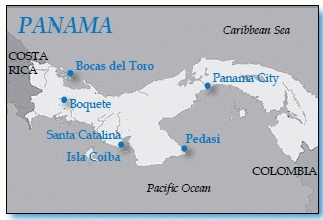 It took us five hours of interesting driving to reach Pedasi, a quiet little
town on Panama's Pacific Coast. The roads are pretty good, but navigation was
troublesome indeed. Along the way, after an hour of driving in circles ("didn't
we just drive past here?"), we realized there were not one, not two, but three
small towns in a 30-mile radius with the same name. The Pedasi we were looking
for has one main drag, a few restaurants, and is close to Playa Venao, a beautiful
Endless Summer-type surf beach, where surfers, mostly Americans, elegantly
ride the waves but then treat the local hotel bar like the back of a truck,
bringing in their dogs, clothes and everything else. The drinks cost me twice
what the surfers paid, a variation on the "locals' price" you get in Hawaii. I
pointed this out to the bartender, who just shrugged.
It took us five hours of interesting driving to reach Pedasi, a quiet little
town on Panama's Pacific Coast. The roads are pretty good, but navigation was
troublesome indeed. Along the way, after an hour of driving in circles ("didn't
we just drive past here?"), we realized there were not one, not two, but three
small towns in a 30-mile radius with the same name. The Pedasi we were looking
for has one main drag, a few restaurants, and is close to Playa Venao, a beautiful
Endless Summer-type surf beach, where surfers, mostly Americans, elegantly
ride the waves but then treat the local hotel bar like the back of a truck,
bringing in their dogs, clothes and everything else. The drinks cost me twice
what the surfers paid, a variation on the "locals' price" you get in Hawaii. I
pointed this out to the bartender, who just shrugged.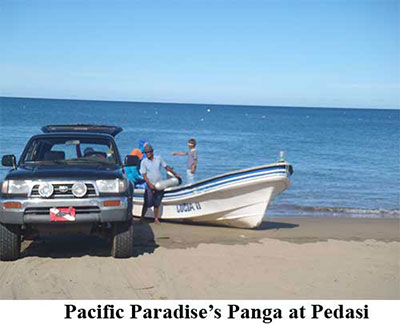 The second dive was Los Hongos (The Mushrooms), a beautiful coral bed of
purple pillar coral, at least 10 acres wide. A few small white-tip reef sharks
swam about, and many eels protruded from holes. We saw large schools of brown
chromis and blueheads, hundreds at a time, and a crocodile needlefish (which I
called a houndfish) four feet long. On both dives, the depth was around 30 feet,
so the sun brought out the coral colors, and we had plenty of bottom time to
explore. I regret not slotting more time for Pedasi.
The second dive was Los Hongos (The Mushrooms), a beautiful coral bed of
purple pillar coral, at least 10 acres wide. A few small white-tip reef sharks
swam about, and many eels protruded from holes. We saw large schools of brown
chromis and blueheads, hundreds at a time, and a crocodile needlefish (which I
called a houndfish) four feet long. On both dives, the depth was around 30 feet,
so the sun brought out the coral colors, and we had plenty of bottom time to
explore. I regret not slotting more time for Pedasi.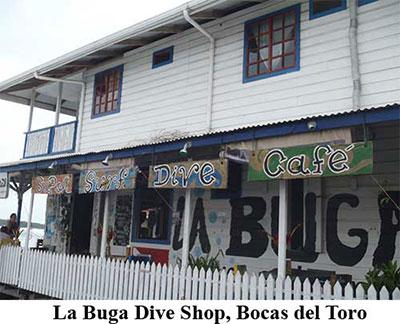 CDC's super panga was serviceable; however, seat cushions with cracked covers
and no real padding were a squishy, soggy, unpadded mess, leading to a butt-painful
rough ride through choppy water. While the staff was friendly and helpful,
our divemaster, a local guy in his mid-30s, was a disinterested exception. His
too-brief briefing on the first dive (with none on the second or third) was negligent
for those of us diving for the first time in those waters. On our third
dive, he was busy with his camera and disappeared (in 20 feet of visibility, even
seeing bubbles was tough). Without guidelines from his briefing, I wondered if we
should follow the normal protocol of searching for one to two minutes, then surface
and regroup. After an awkward three minutes, we swam in the direction we had
seen him go. When we caught up with him, he appeared to have no idea we had been
"lost." When we got to the air level that he indicated in his only briefing, we
rose to make a safety stop, but he kept swimming around at 35 feet taking pictures.
Back on the surface, I munched the sandwich I had made from the white
bread and peanut butter purchased at the local bodega, while the crew sliced up
fresh pineapples for themselves.
CDC's super panga was serviceable; however, seat cushions with cracked covers
and no real padding were a squishy, soggy, unpadded mess, leading to a butt-painful
rough ride through choppy water. While the staff was friendly and helpful,
our divemaster, a local guy in his mid-30s, was a disinterested exception. His
too-brief briefing on the first dive (with none on the second or third) was negligent
for those of us diving for the first time in those waters. On our third
dive, he was busy with his camera and disappeared (in 20 feet of visibility, even
seeing bubbles was tough). Without guidelines from his briefing, I wondered if we
should follow the normal protocol of searching for one to two minutes, then surface
and regroup. After an awkward three minutes, we swam in the direction we had
seen him go. When we caught up with him, he appeared to have no idea we had been
"lost." When we got to the air level that he indicated in his only briefing, we
rose to make a safety stop, but he kept swimming around at 35 feet taking pictures.
Back on the surface, I munched the sandwich I had made from the white
bread and peanut butter purchased at the local bodega, while the crew sliced up
fresh pineapples for themselves.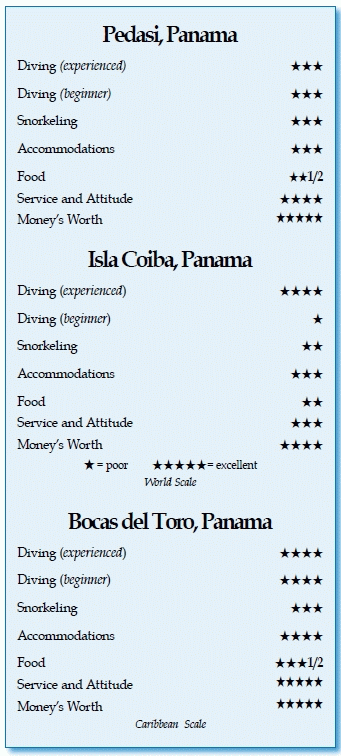 Next stop on our Panama ramble
was the mountain town of Boquete, at
a 4,500-foot elevation in a famous
coffee-growing region, but with so
many birds and butterflies, it felt
like a land-based reef. After roughing
it the day before, the Boquete Garden
Inn seemed luxurious. Then on to Bocas
del Toro, on the Caribbean side of
the isthmus. We dropped off our rental
car in David because our plan was to
depart from Bocas del Toro's airport
back to Panama City for the trip home.
From Boquete, we took a $30 shuttle
over the mountains to Almirante to
catch a water taxi to Bocas del Toro
on the Caribbean side. Along the way,
we stopped at a roadside watering
hole, populated with indigenous people
in bright colors and interesting hats,
reminiscent of Ecuador. One family was
transporting their dog in the back of
a truck; he was in a rice sack with
his head sticking out, so he couldn't
jump from the truck. Perro in Bolsa
instead of Cat in the Hat.
Next stop on our Panama ramble
was the mountain town of Boquete, at
a 4,500-foot elevation in a famous
coffee-growing region, but with so
many birds and butterflies, it felt
like a land-based reef. After roughing
it the day before, the Boquete Garden
Inn seemed luxurious. Then on to Bocas
del Toro, on the Caribbean side of
the isthmus. We dropped off our rental
car in David because our plan was to
depart from Bocas del Toro's airport
back to Panama City for the trip home.
From Boquete, we took a $30 shuttle
over the mountains to Almirante to
catch a water taxi to Bocas del Toro
on the Caribbean side. Along the way,
we stopped at a roadside watering
hole, populated with indigenous people
in bright colors and interesting hats,
reminiscent of Ecuador. One family was
transporting their dog in the back of
a truck; he was in a rice sack with
his head sticking out, so he couldn't
jump from the truck. Perro in Bolsa
instead of Cat in the Hat. Divers Compass: No nitrox was available anywhere we went . . .
The whole Casco Viejo area in Panama City is rich with historical
significance . . . If you haven't yet, read The Path Between
the Seas by David McCullough to put Panama's names and places in
context. . . Websites: Pacific Paradise Dive Shop -
Divers Compass: No nitrox was available anywhere we went . . .
The whole Casco Viejo area in Panama City is rich with historical
significance . . . If you haven't yet, read The Path Between
the Seas by David McCullough to put Panama's names and places in
context. . . Websites: Pacific Paradise Dive Shop - 